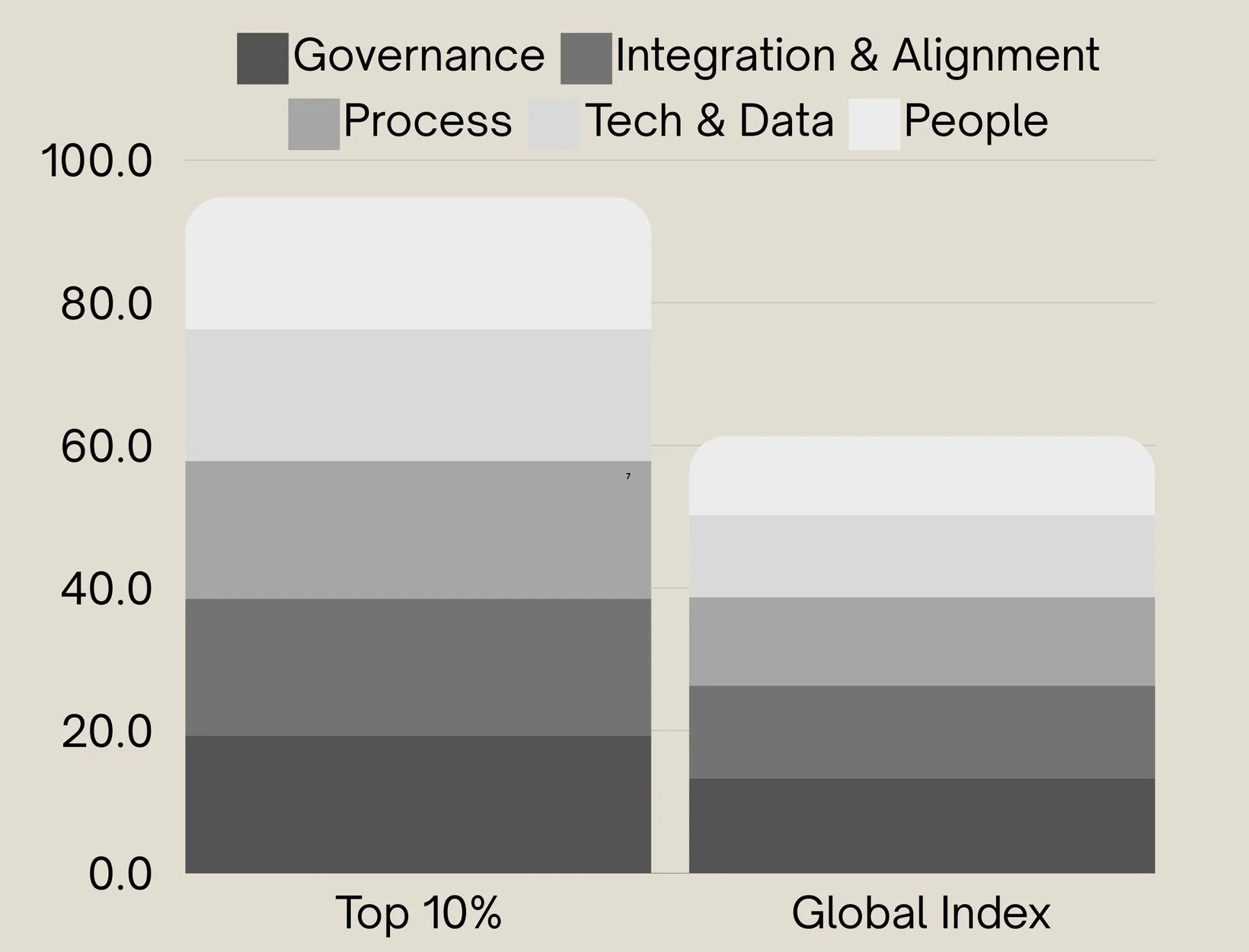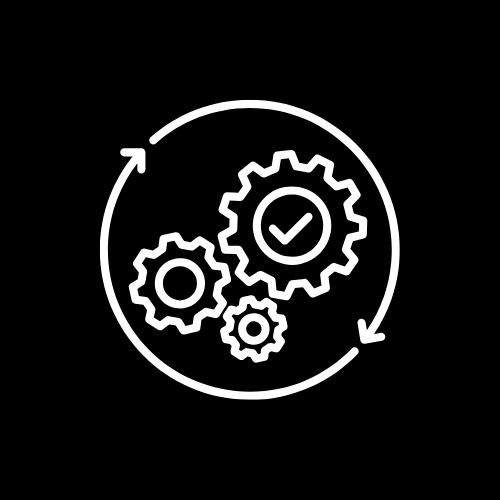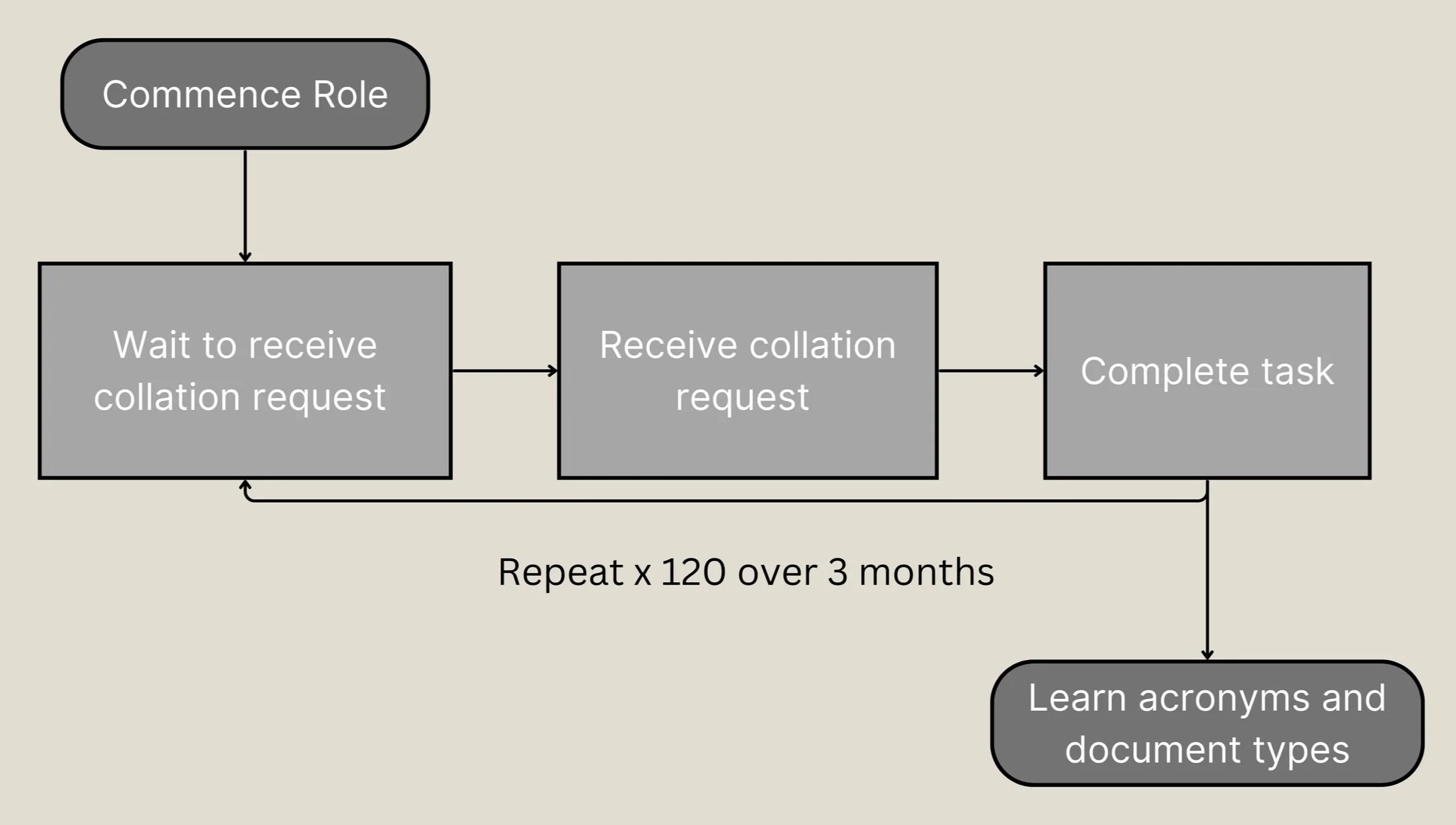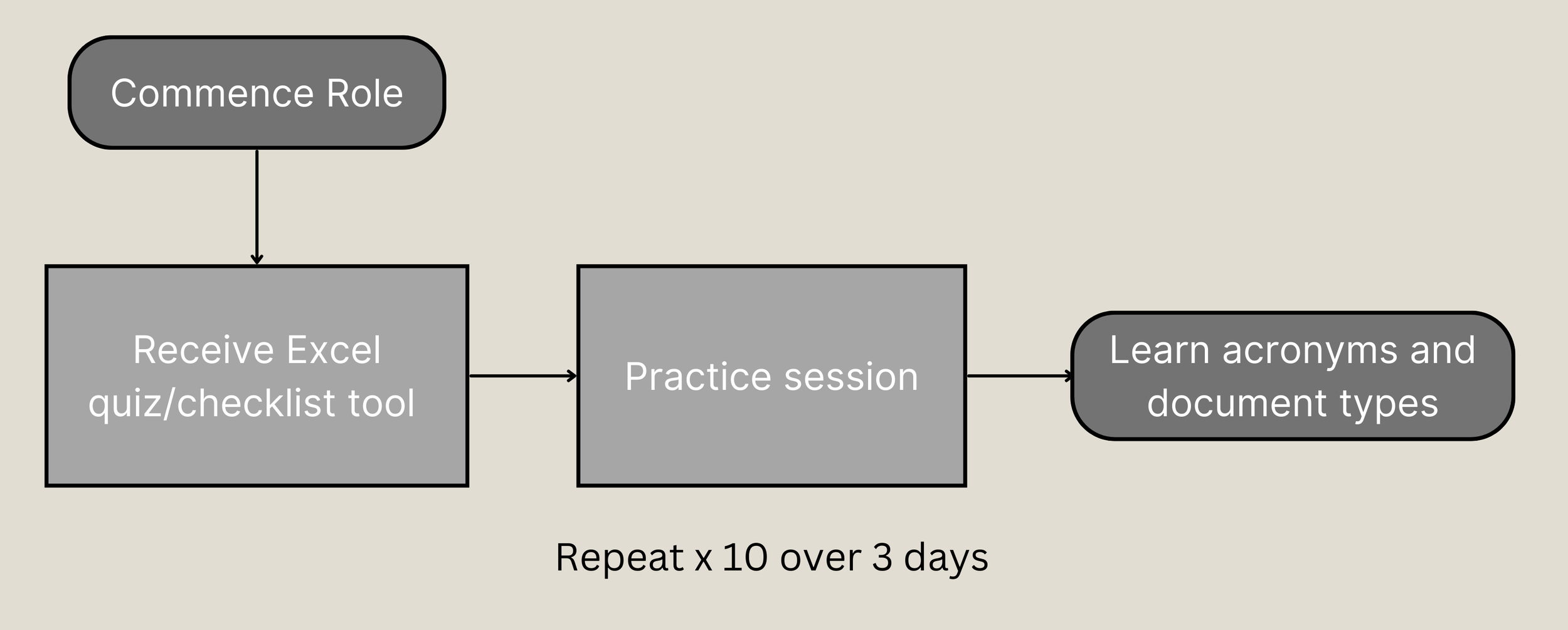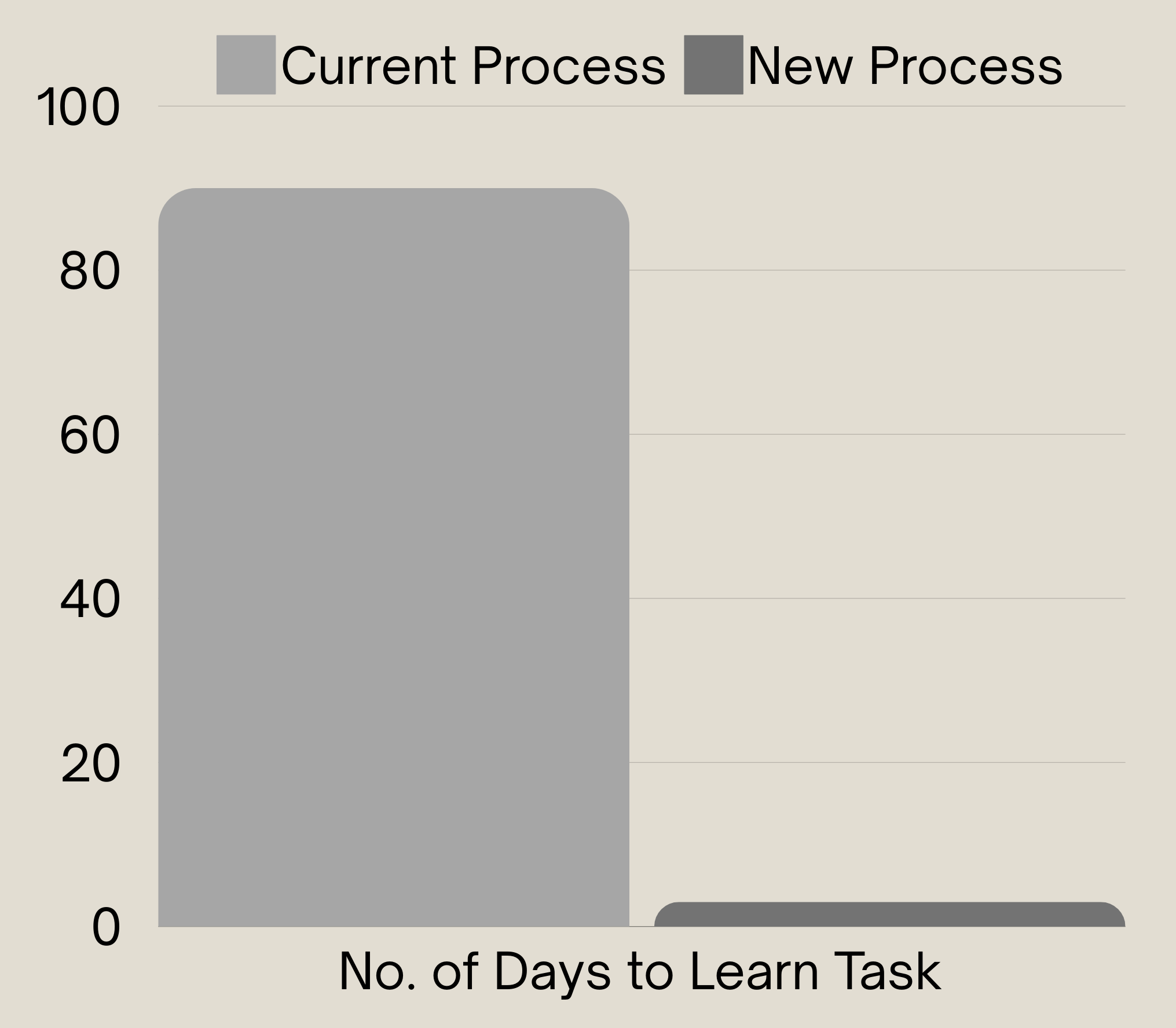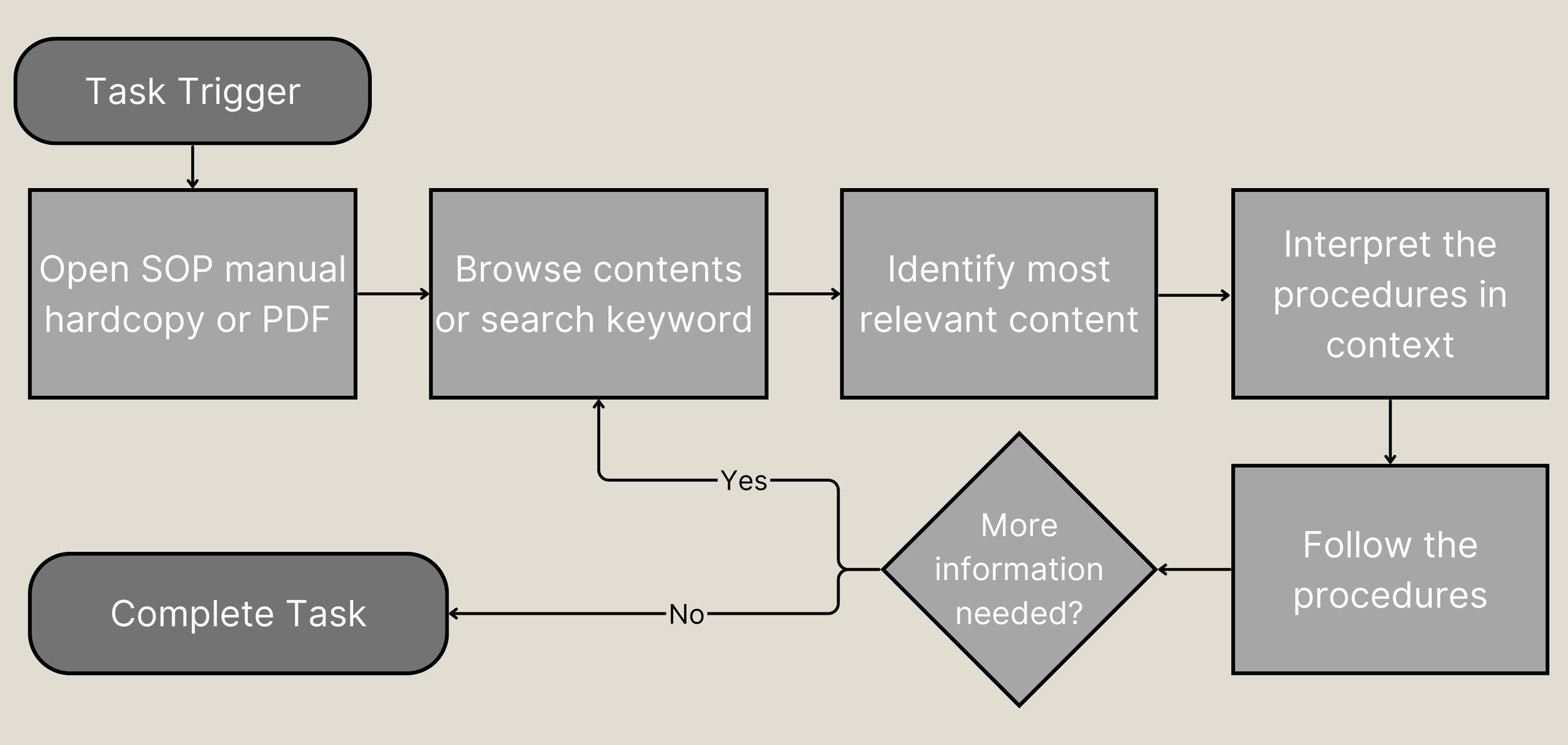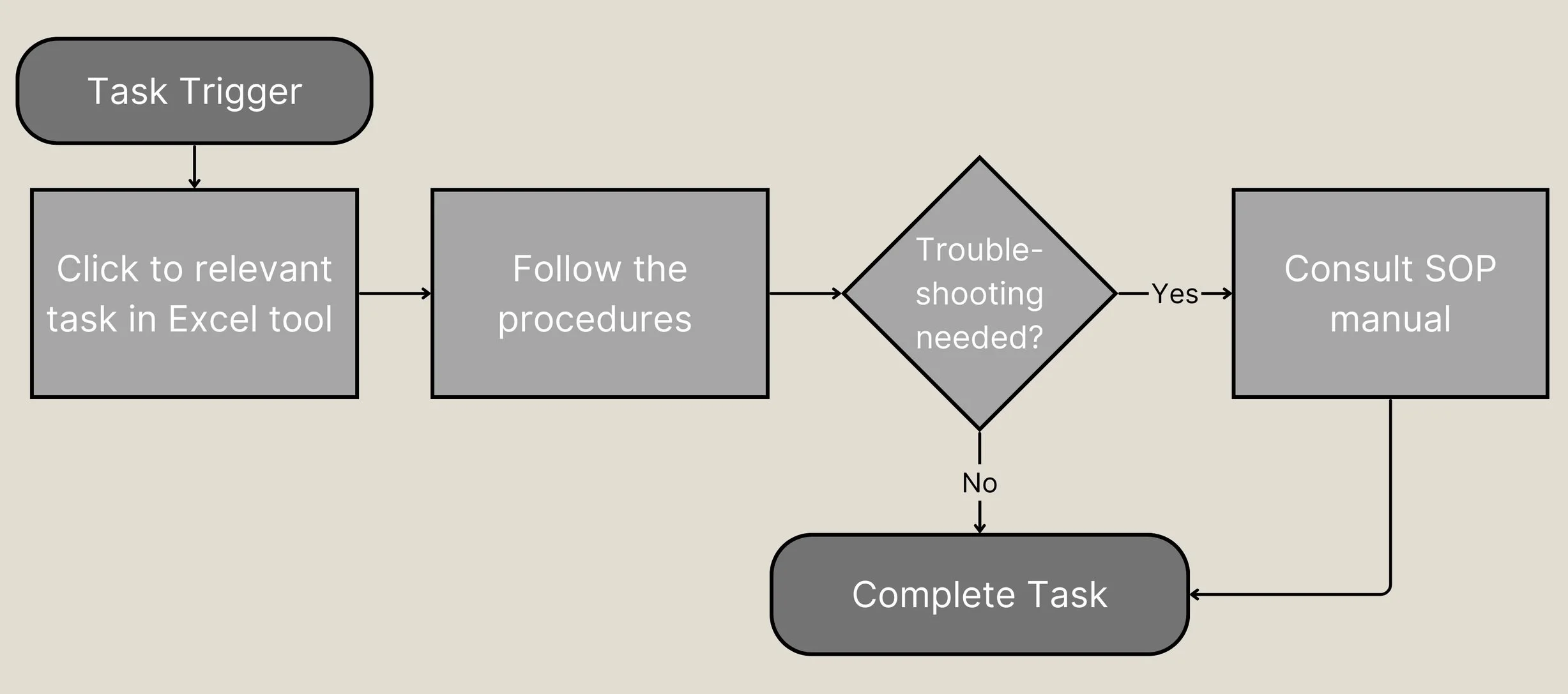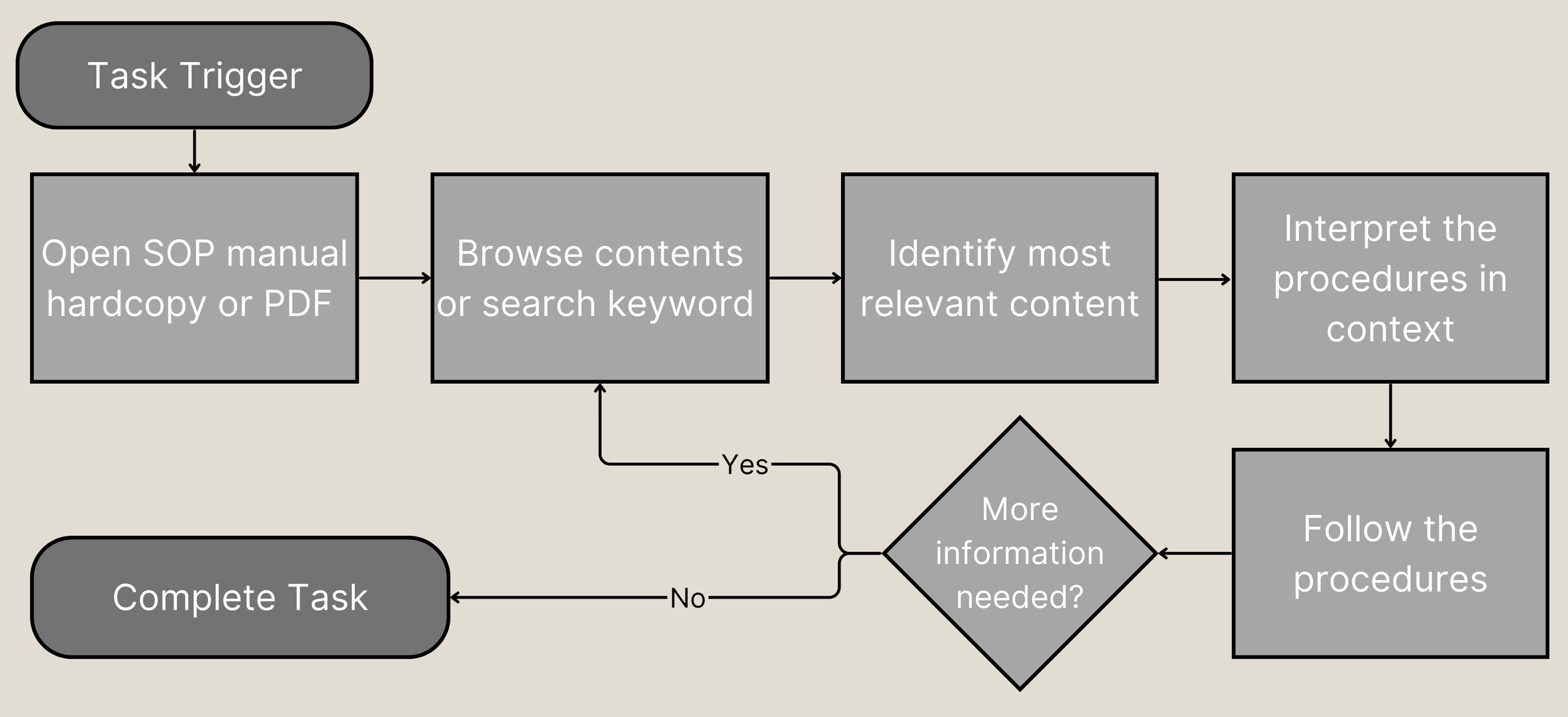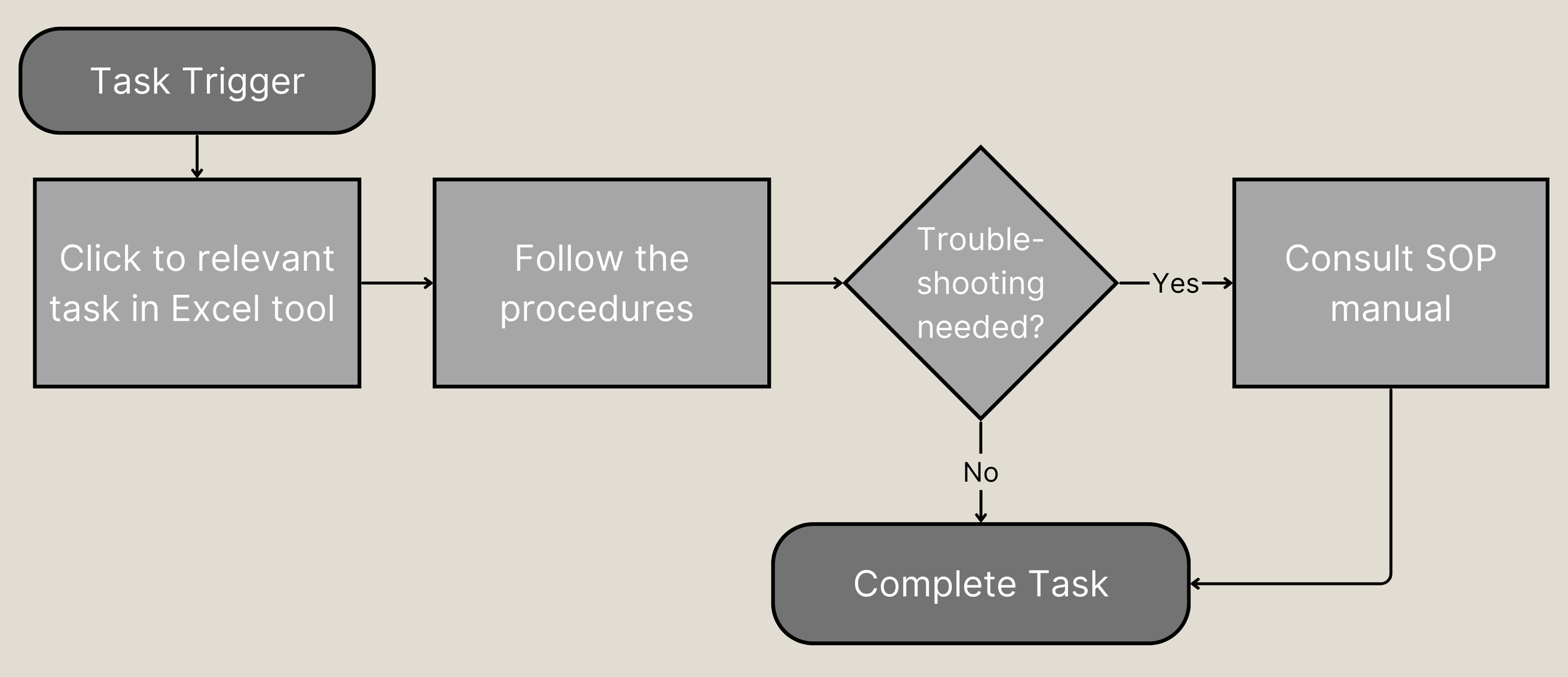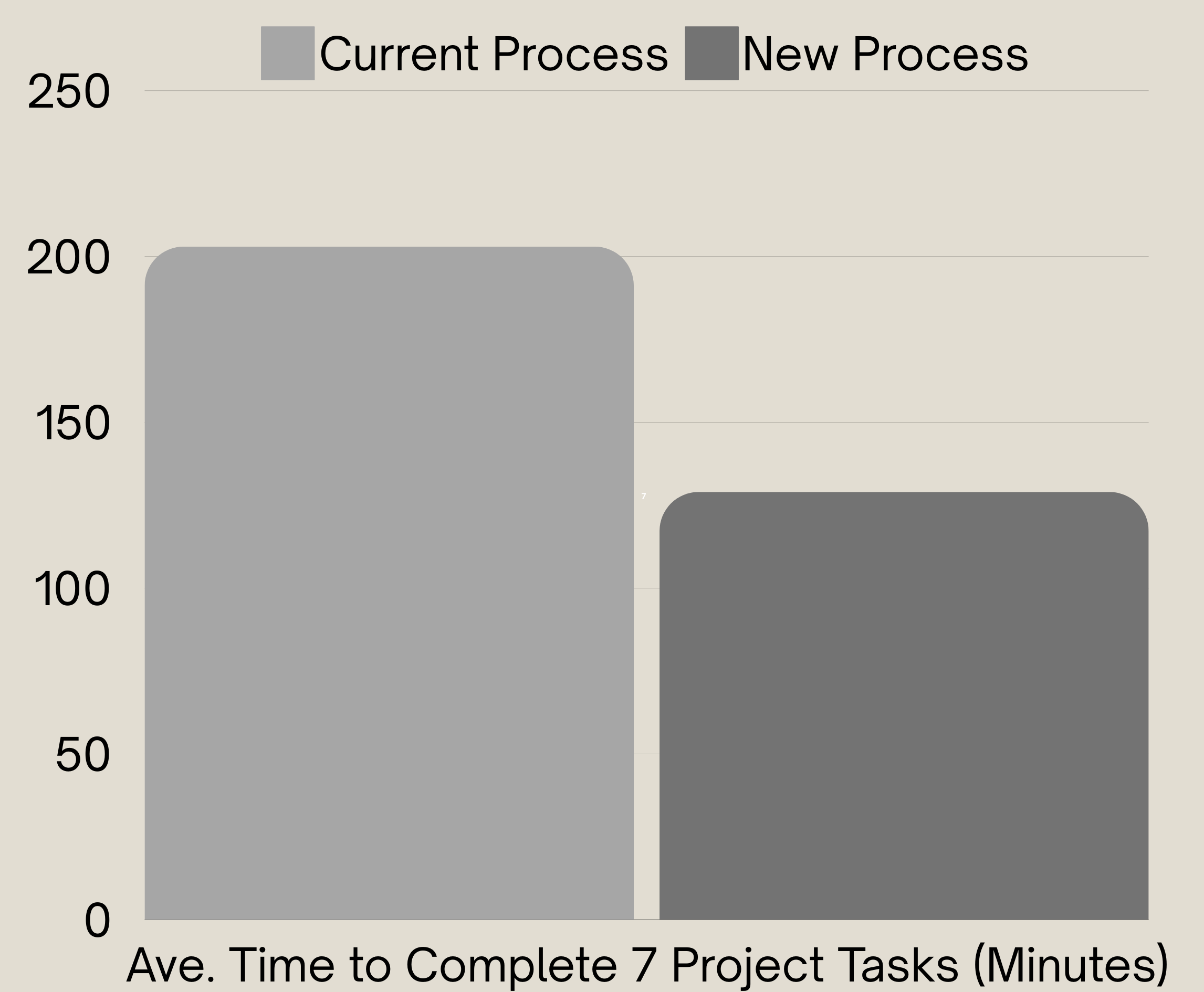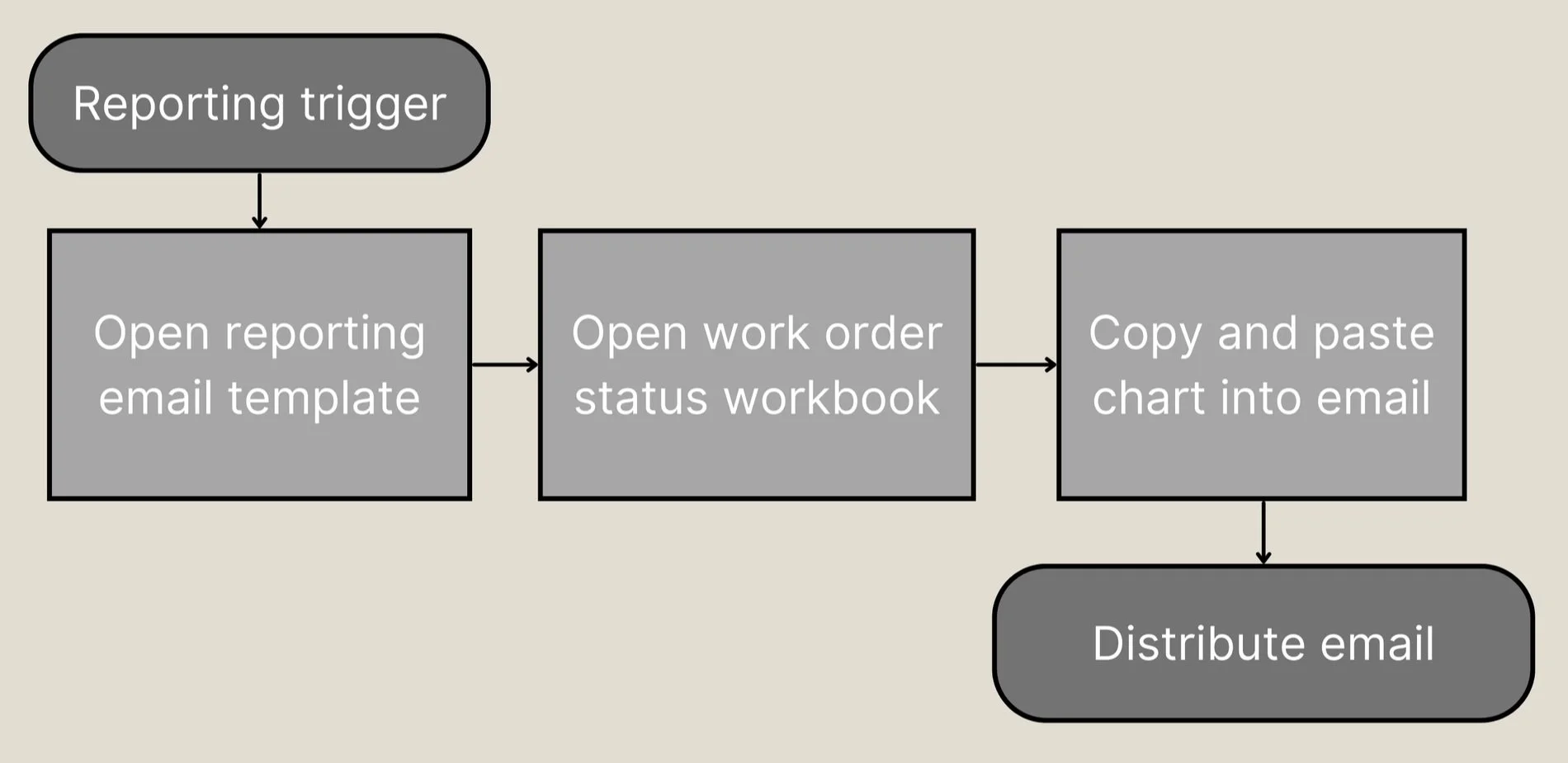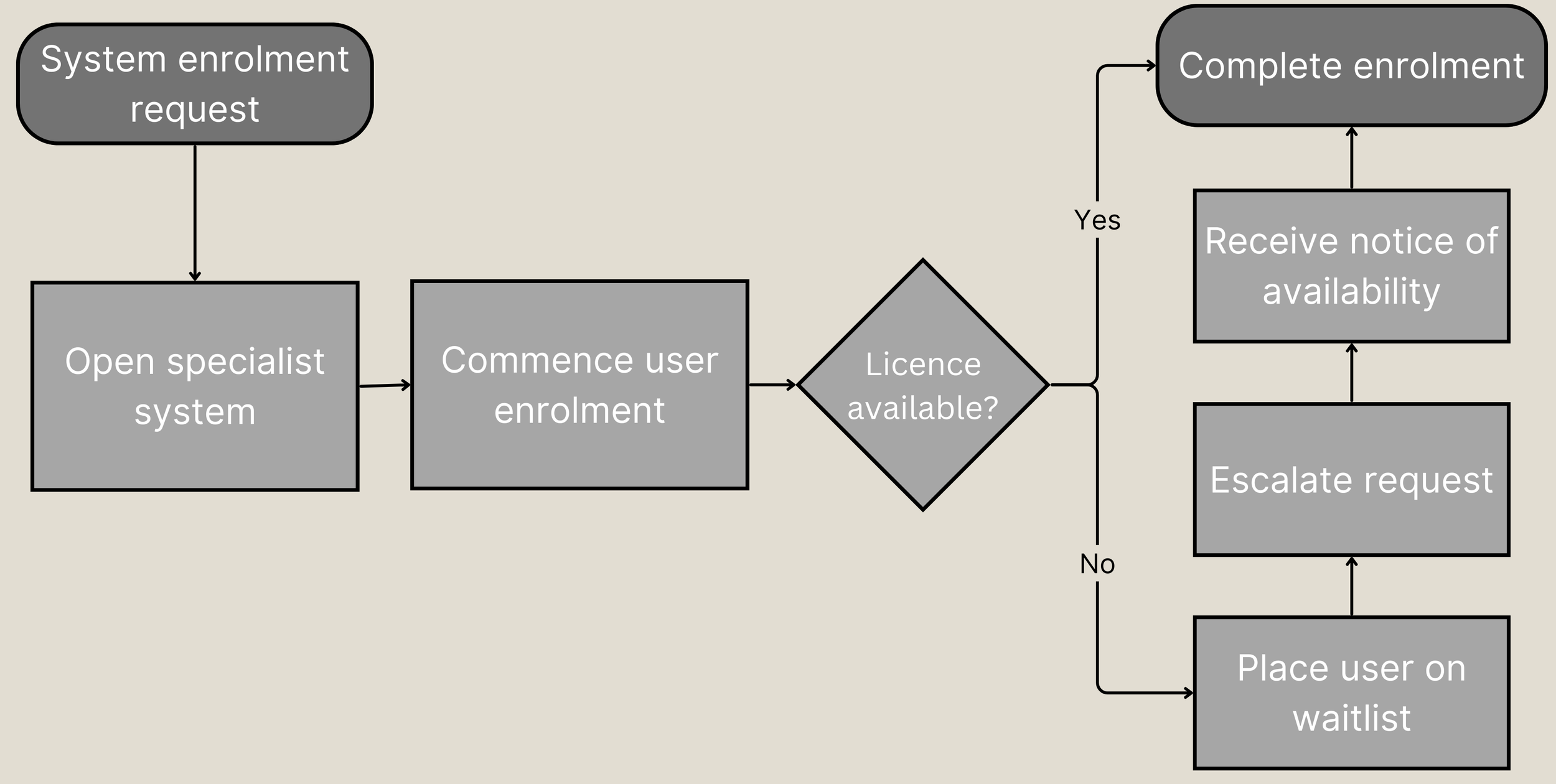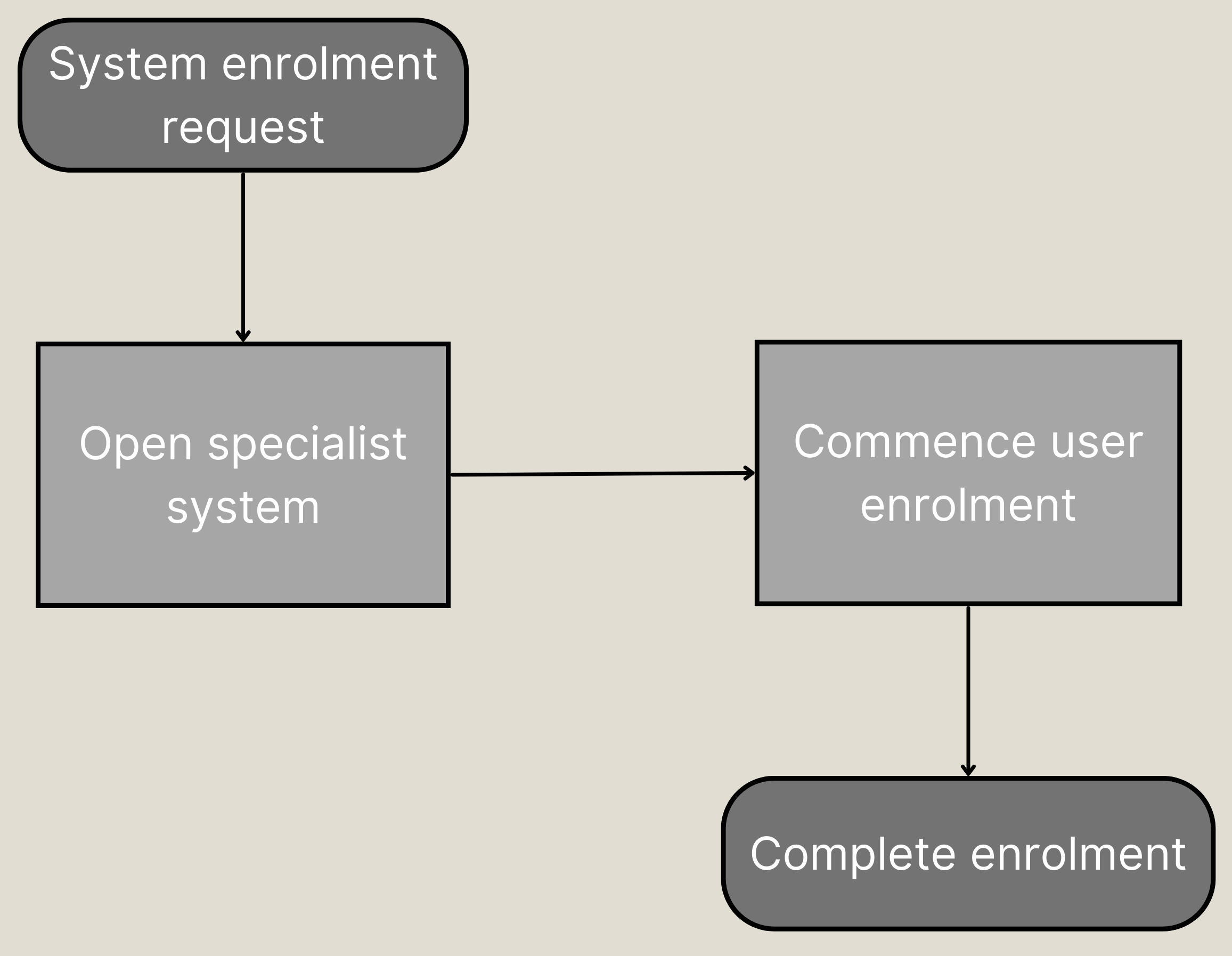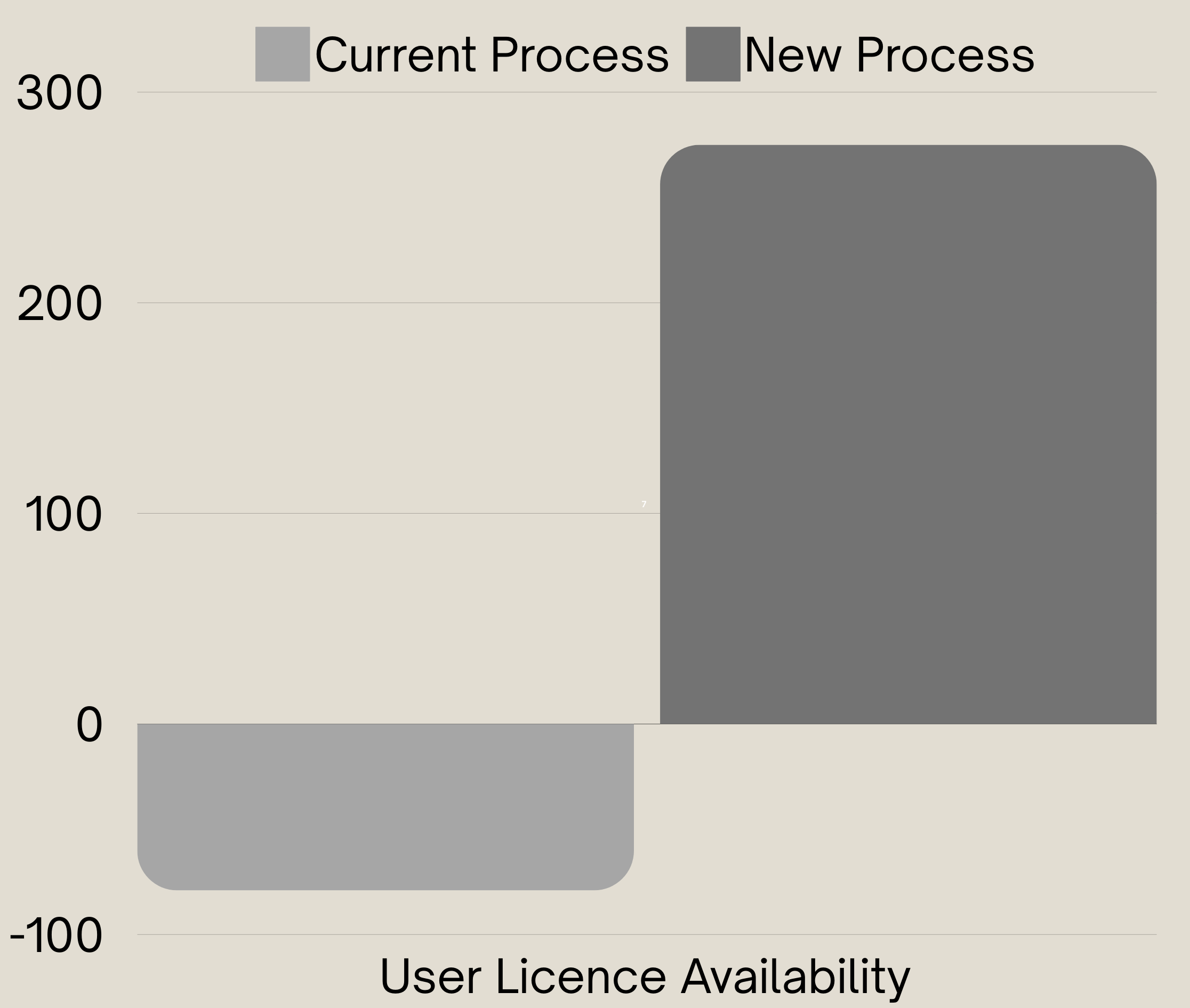
Overview
Organisation: Marine engineering service
Structure: SME
Lifecycle stage: Maturity
Goal: Efficiency and industry competitiveness
Solution: Process improvement
Technology: Microsoft 365 and Power Platform
Project duration: 3 months
This case study is comprised of five smaller projects completed at more than one company, here in the scenario of a Sydney marine engineering SME, towards process optimisation, digitalisation, and automation within a project management team, including: interactive training tool, business process flow prototype, interactive digital procedures manual, interactive automated project reporting, and resource demand forecasting across administration services, software licensing, and inventory management. Strategy analysis, root cause analysis, process analysis, process modelling, prototyping, and testing techniques were used to explore the underlying problems and design a basic solution for each process that could be developed further using the more advanced capabilities of Microsoft today.
Analysis
PMO Maturity of Top 10% (94.9%) vs Global Index (61.4%)
Source: PMI and PwC (2021), cited in PMI (2022).
Strategy
“Unless capabilities-building is recognised and treated as the central enabler of successful strategy execution, organisations will be unable to meet their goals, projects will falter, and the profession as a whole will be unable to avoid the impact of a global talent crisis.” - PMI, 2021.
PMI and PwC (2021) created a Global PMO Maturity Index, measuring PMO performance of over 2000 companies against five key areas of PMO maturity: governance, integration, process, technology and data, and people (learning and development). PMI (2022) found that there was a striking difference between the performance of a group titled the Top 10% and the rest, and that the lower performing group struggled more in the areas of process, technology and data, and people, than in core areas of governance and integration, while the Top 10% performed well across all five domains. This finding resonates with the case study here presented, of a project administration team at a marine engineering SME.
The project administration team utilised around three main systems in daily operations, with Microsoft Office 365 used for productivity, including a SharePoint intranet, Excel for all data and performance management, and other software used for finance and work order management. Observation conducted within the team revealed opportunities to improve efficiency through introducing additional methods for learning, knowledge sharing, and enablement (people), more closely aligning project administration processes with organisational objectives (process), and to look into how these improvements could be scaled and amplified using the capabilities of Microsoft Power Platform and Copilot (technology and data).
PMI (2021) examined the recruitment, development, and retention of project management talent in the results of a survey undertaken with PwC of over 4000 leaders in P3M (project, program, and portfolio management) and identified a core problem as the lack of a business case for investing in this area, one which aligns capabilities to organisational strategy and competitive advantage. As a result, organisations find it difficult to recruit for the project management capabilities they need, and the number one barrier identified to developing these capabilities was that L&D wasn’t enough of a strategic priority (PMI, 2021), with only 51% of organisations promoting a culture of continuous learning and 22% monitoring the use of training.
In a related area, PMI (2024) looked at the impact of enablers on project success among participants in its PMI Annual Global Survey on Project Management 2023, enablers defined as supportive programs to help individuals and teams learn new skills, and found 8.3% better project performance among those reporting to have three or more enablers. Examples of enablers include training on new ways of working, coaching and mentoring, and communities of practice. Although two-thirds of leaders surveyed reported that their teams needed new or different technical skills, power skills, or business acumen skills, under one-half said they used even one enabler, and only one in four prioritise learning culture or employee engagement.
The issue of capabilities naturally interweaves with that of processes, and technology and data, as without knowledge, support, and enablement to effectively use existing technology and data towards executing processes to achieve project objectives, organisational moves to integrate and deploy advanced technologies such as generative AI and AIML could face a more intensive and costly catch-up effort in providing teams the training, support, and resources they need to not only adapt to them, but to take advantage of their potential and utilise creative problem solving to continuously improve organisational processes and outcomes.
Best Practice: What do top-performing PMOs do?
PMI (2022) highlights the behaviours of the Top 10% in the Global PMO Maturity Index that contribute to their success across all five of the maturity areas:
In 89% of the Top 10%, PMOs contribute to strategy development all the time;
94% ensure KPIs and initiatives are aligned with organisational goals;
92% continuously adapt tools, methodologies, and practices for different projects and teams;
88% continuously help to develop strong personal skills in project managers;
They are strong adopters of the latest project- and program-level tools, with a focus on enhancing functions like collaboration, visibility, and knowledge-sharing;
65% have adopted data analytics and 59% are using automation solutions;
69% promote a continuous learning culture; and
64% provide coaching, mentoring, and shadowing.
Recommendations
Having achieved integration and alignment across its main software systems, the organisation could reach an even greater level of synchronicity and, in turn, project performance and client satisfaction, through investing a small amount of time into optimising the deployment of these systems to their maximum capabilities.
The organisation could attain this through, firstly, closely examining their existing processes in how they make use of the systems, and identifying untapped value that might be found in the more modern functioning available in today’s Microsoft suite, from Power BI, through to the Power Platform and its automation, and AI in Copilot.
Specifically, increasing the use of enablers to promote and develop the capabilities of the project administration team in its performance of daily operations could provide a quick win by enhancing the support provided to the project management team, before scaling through the broader project team and across the organisation.
Process Improvement Plan
Microsoft Power Platform and Copilot
Microsoft Power Platform was launched in 2019 in response to rapid growth in Big Data and mass adoption of cloud, and was initially comprised of its first Power product, Power BI, along with the newer PowerApps and Flow. Power Platform was designed to allow enterprise users in a range of roles to leverage business data in three ways: Analyse, Act, and Automate. In 2022, Forrester conducted 33 interviews with companies using Microsoft Power Platform premium products, with aggregate revenue $3B and over 10,000 employees, to evaluate its Total Economic Impact. This study was undertaken pre-ChatGPT and Microsoft Copilot, when the Power Platform had been expanded and developed to include Power BI, Power Apps, Power Automate, and Power Virtual Agents. Forrester (2022) found that these premium users gained an average three-year ROI of 140%, with net present value of $8.32M, and also experienced a 45% cost reduction on application development. By adopting the premium Microsoft Power Platform as it is today, with its AI-driven Copilot and Copilot Studio, and perhaps considering Dynamics 365, the project management team and its administrative support can benefit from process streamlining and automation, enhanced decision-making, and the potential to generate reports and documents with natural language queries. Copilot’s AI features also allow processes to be analysed on an ongoing basis, using feedback and data to refine them, recommending ways to optimise them for improved efficiencies in recurring tasks, and to remove bottlenecks in workflows.
People: Training
Microsoft Viva is an employee experience platform that offers communication, knowledge-sharing, engagement, insight, learning and development, and performance management. Microsoft Viva (2024) explains how the product can be used to assist in an AI transformation by supporting employees. Integrating Viva with Power Platform and Copilot can assist with creating personalised learning paths for team members, and Copilot can provide hyper-personalised training content and quizzes based on users’ interaction with tools. Meanwhile, Power Apps enables creation of a tailored training platform where employees can access SOPs, manuals, and videos and Copilot integrated can answer natural language queries about procedures and best practice.
Technology: Data Management
Instilling strong data management practices into project support team procedures beyond project management work order progress to the project holistically helps to build a data culture which is inclusive of newer team members who may lack knowledge or experience in the area, while helping the team prepare for AI adoption in the future. Microsoft offers a range of advanced business intelligence and data management applications beyond Excel, with Dataverse able to be integrated with Power BI and other Power Platform applications, as well as to Microsoft Fabric, while Copilot can be used to generate insights from consolidated data, and other AI tools can assist with predictive analytics and forecasting.
Process: Workflow
With temporary contractors often hired to support the project management team, workflow tools could be introduced to aid speedier learning of daily tasks and procedures that build on the prototypes described below. Microsoft Power Automate can seamlessly automate tasks like project updates, document approvals, and task delegation. Copilot can proactively suggest tasks and automate project administration duties such as scheduling, notifications, and reminders based on workflow patterns. Lastly, Power Platform offers dynamic workflow mapping with process visualisation, and Copilot can also enhance these workflows by suggesting improvements and identifying inefficiencies based on usage patterns.
The Story of the Project Management System
Project management systems exist in many different forms and are used today in a variety of situations, from property development with the most advanced software to managing a home reno with a mobile app. The tools and principles behind project management were innovated over generations and have seen humanity through the toughest of times, while helping us make the most of prosperity during economic booms. The project management system has quite a story to tell about where we’ve been, where we are, and where we could go next. Read more…
Quick Wins
Process 1: Interactive Training Tool
Challenge
Collating a complex document required referencing a hardcopy or PDF list of over 30 document titles and their acronyms, which anecdotally took approx. three months for admin staff to memorise through on-the-job practice. Each time the collation needed to be prepared, the documents uploaded to the system were checked against those on the list, ensuring mandatory documents were present and removing excluded documents as necessary. This process resulted in occasional error due to workload, distraction, or fatigue, requiring rework and delaying approval.
Solution
Created an interactive spreadsheet using Excel that could be converted from a training quiz to an on-the-job checklist through simple column hiding and unhiding, and kept open unobtrusively on the far left or right side of the screen, being only two columns wide. The design of the quiz enabled immediate feedback and unlimited attempts, and the checklist could be customised through colour coding of document types by the user. The checklist function could possibly be integrated into the document management system eventually through automatic document recognition to eliminate this task from project administration.
Results
This trivial tool reduced time to learn document collation from three months on-the-job practice to three days online training. Task completion time reduced during first three months from 7.5m to 5m (x 10 collations p/wk x 12wks = 300m/5hrs) and after three months from approx. 5.5m to 4m. Risk of error reduced throughout training period and beyond first three months (subjectively assessed).
Process 2: Business Process Flow Prototype
Challenge
The project administration role required following a lengthy manual and text-based guide to complete eight routine project support tasks, where high-level process diagrams were unable to convey certain practical details, leading to difficulty and delay in achieving task proficiency, inefficient task execution, and workflow interruptions.
Solution
Developed an Excel tool with a vertical flowchart for each daily task, fitting on the side of the screen, and arranged sequentially to enable an understanding of where each task fit into the broader project management process. Sized at one column enabled focusing on the task at hand and moving through each task with just one click.
Results
This tool reduced time taken for staff in training to complete daily project support tasks from 25-33m per task to 17-20m on average, lowering risk of error through step-by-step instructions, and was subjectively indicated to allow easier proficiency and understanding of how the role contributes value to the team through these day-to-day tasks.
Process 3: Interactive Digital Procedures Manual
Challenge
An SOP manual provided an abundance of invaluable information about the overall project management function within the organisation and the duties that were performed by other members of the project team, but the disconnection of the manual from everyday routines limited the extent to which project administration staff, especially those in training or on a temporary contract, could absorb its content and learn in-depth how to make a significant contribution in sufficient time to put it into practice.
Solution
Further to the task flowcharts created in Process 2, two process maps were created here: one a swimlane chart of the project management team workflow from the start to finish of a typical project, for which the information was primarily taken from observation and practical experience, and the second diagram a tabulated chart showing high-level major project phases; key tasks, milestones, and deliverables performed by the overall project team during each phase; as well as important concepts and terms, with details of each displayed upon hovering with the cursor; the information for the latter having been extracted directly from the SOP manual.
Results
By extracting and digitising core information from the SOP into a tabulated process map at PMO level, creating a swimlane process map at team level, and integrating these two charts with the original task flowchart at admin level into three interlinked worksheets within the one Excel workbook, and adding the Excel tool from Process 1, it effectively digitised the SOP along with other procedural knowledge acquired through on-the-job experience, and opportunity was created for new or temp staff to access higher-level organisational project management information for learning while carrying out day-to-day tasks, where such information could be put in context and applied, enabling faster learning at a deeper level, rather than merely through separate reading.
Process 4: Automated Project Reporting
Challenge
The manual process of preparing regular project status reports was time-consuming and prone to errors, with information presented in long text-based emails, making it difficult for team members to quickly access relevant details. It involved gathering relevant work order progress data from one system and entering it manually into the email in list format, requiring scrolling down through the email by the user to find information.
Solution
An existing job status spreadsheet was given a refresh to encourage staff use and a routine established to update project work status at least daily. A reporting worksheet was then created with a modified template of the email report designed to access the status sheet and automatically update upon any changes in it. Thirdly, a data visualisation was created in the worksheet template from the template job status data so that it reflected up-to-date work order status at all times and was easily pasted into the email for distribution. The colour-coded stacked-bar chart facilitated at-a-glance access to all relevant information for viewers of the email, without scrolling or performing mental sorting, filtering, or calculation.
Results
These steps reduced the average reporting preparation time from 22 minutes to 7 minutes. With frequency of reporting varying from weekly to daily depending on project stage, the new format could save up to 1.25 hours per week. Positive feedback was also received from the team member recipients of the reporting email, and overall the new process provided greater learning opportunity for project administrator preparing it, through both the regular maintenance of the detailed project status data and gaining a big picture view of project progress.
Process 5: Resource Demand Forecasting
Challenge
The last process reviewed within the project administration team was resource management; specifically, staffing, software licensing, and office inventory. Similarly to the previous four processes, this review was initiated upon identifying opportunity for improvement in performance and outcomes when project administration staff were faced with conflict between managing on-site and in-office obligations, new staff were unable to perform their duties due to software licensing limits being exceeded, and a stocktake being requested of office inventory to plan purchasing over the following quarter raising awareness of a lack of inventory records or purchase monitoring. Each of these events revealed an absence of forecasting or digital recording processes that could mitigate such challenges.
Solution
Firstly, paper records of a process that required in-office attendance were digitised and analysed, identifying consistent service demand patterns by day of the week, ranging from nil demand to high demand, which would allow for reliable forecasting and introducing flexibility and contingency into project administration staff attendance in-office while also meeting on-site responsibilities. Secondly, an audit was undertaken of a specialist system which had exceeded licensing requirements, risking additional costs being incurred, and identified a large number of users whose accounts had lapsed through non-use over a defined period and were eligible for deactivation, enabling the enrolment of new users. Based on an analysis of system enrolments over the past twelve months, a forecast of licensing needs over the next half-year was created and a routine established of removing inactive users to ensure adequate availability. Thirdly, a simple recording and forecasting model of office stock inventory was created for the purpose of recommending documentation, monitoring, and analysis of this data in the future to enable purchase planning and budgeting as needed.
Results
Overall, this project highlighted the value of data and documentation in business resource management and the benefits of processes such as forecasting in simple processes with fairly consistent patterns and trends. The main benefit in this scenario was managing risks associated with exceeding software user licensing requirements such as financial cost or staff and contractors not being able to access the application to fulfil their duties, impeding progress of a project and imposing additional duties on staff who do have access to the system. At the same time, allowing staff involved with enrolment in the system to carry out their support of users efficiently and in the knowledge that adequate licences are available.
Summary & References
In this series of undertakings within the project administration team at an engineering SME over a period of three months a small impact was able to be made on processes in training, workflow, productivity, reporting, and resource management using Microsoft 365, principally Excel. Process improvements in these domains and across the larger business for this SME or any small business could be achieved through even a meagre investment in bringing visibility to processes and mining them for value-adding opportunities, optimising them, and maximising the benefits of software systems such as Microsoft 365, Power Platform, and Copilot by more closely aligning their capabilities with organisational objectives. Such seemingly trivial bottom-up initiatives can provide a useful starting point for an organisation to enable its people, optimise its processes, and make the best use of its technology, hence moving forward towards greater PMO maturity and better project outcomes.
REFERENCES
Forrester (2022). The Total Economic Impact Of Microsoft Power Platform Premium Capabilities. A Forrester Total Economic Impact Study, August 2022.
Microsoft Dynamics 365 Team (2019). The Microsoft Power Platform - Empowering millions of people to achieve more.
Microsoft Viva (2024). The state of AI change readiness: Accelerating AI change through employee experience.
Project Management Institute (PMI, 2024). Pulse of the Profession 2024. The future of project work: Moving past office-centric models. 15th Edition.
PMI (2022). PMO maturity: Lessons from the global top tier.
PMI (2021). Narrowing the talent gap: How to be a frontrunner in the race for talent.
PMI and PwC (2021). PMI and PWC global survey on transformation and project management 2021, in PMI (2022).

